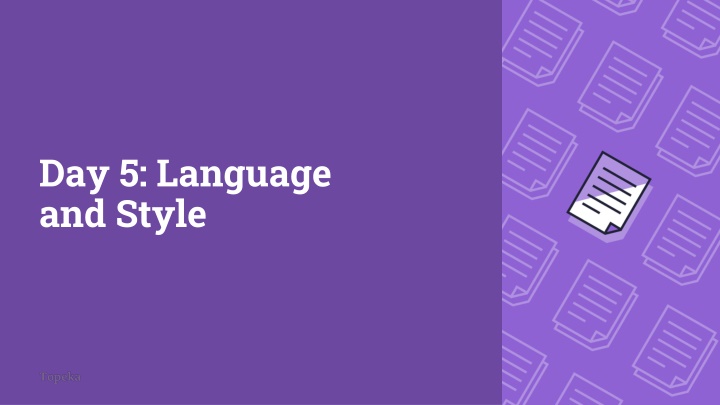
Formal and Informal Language Styles for Effective Communication
Learn about the differences between formal and informal language styles, and how to tailor your communication to suit your audience. Discover the importance of considering your audience's knowledge, perspective, and expectations, and how it can impact the strength of your arguments. Explore the characteristics of formal and informal language styles through practical examples. Enhance your language and communication skills to effectively engage with diverse audiences.
Download Presentation

Please find below an Image/Link to download the presentation.
The content on the website is provided AS IS for your information and personal use only. It may not be sold, licensed, or shared on other websites without obtaining consent from the author. If you encounter any issues during the download, it is possible that the publisher has removed the file from their server.
You are allowed to download the files provided on this website for personal or commercial use, subject to the condition that they are used lawfully. All files are the property of their respective owners.
The content on the website is provided AS IS for your information and personal use only. It may not be sold, licensed, or shared on other websites without obtaining consent from the author.
E N D
Presentation Transcript
Day 5: Language and Style 1
Entry Ticket Complete the Entry Ticket activity to determine whether each statement uses formalor informal style. Afterward, discuss your answers with a neighbor. 2
In this lesson, you will learn 1 2 3 what audience is how to consider your audience what is formal and informal style 3
What is an audience? Your audience is the group of people to whom you are presenting your argument. 4
Why does audience matter? The language and style of your argument should be chosen to appeal to your audience. Choosing appropriate words and style will make your argument stronger. 5
Consider your audience. What they know: Their point of view: Nothing about the topic Some may agree Some may disagree Many things about the topic 6
Consider your audience. Their standards: The occasion: Some expect casual Students in the lunchroom vs. Students reading the school newspaper Some expect formal 7
Think about your audience. Strong arguments include language that will appeal to your audience from all of these different angles. 8
Style is seen in the choices a writers makes about vocabulary, sentence structure, and organization. What are formal and informal styles? Formal Informal Formal style is the use of impersonal, objective, and precise language. Informal style uses conversational, subjective, or slang language. In his op-ed, the author outlines a number of outdated practices that remain ingrained in school systems. This guy is giving his opinion about a bunch of things schools still do because they just can t get with the times. 9
Formal word choices are How does formal style affect word choice? grammatically correct; polite; technical and precise; full words, not contractions or abbreviations; and not slang. 10
How does formal style affect sentence structure? Formal sentence structures use complete sentences; varied sentence beginnings; and key transitional words and phrases that show relationships between sentences and paragraphs. 11
Formal organization uses How does formal style affect organization? formal structure with introduction, body, and conclusion; clear organizational structure; and fully developed paragraphs. 12
When is formal style appropriate? When the subject is serious and important When the audience contains authority figures When the writer is unfamiliar with the audience 13
You do it together. Complete Step 1 to identify and correct informal style in the sample statements. 2
Independent Application Complete Step 2 to identify and correct informal style in the sample paragraphs. 2






















